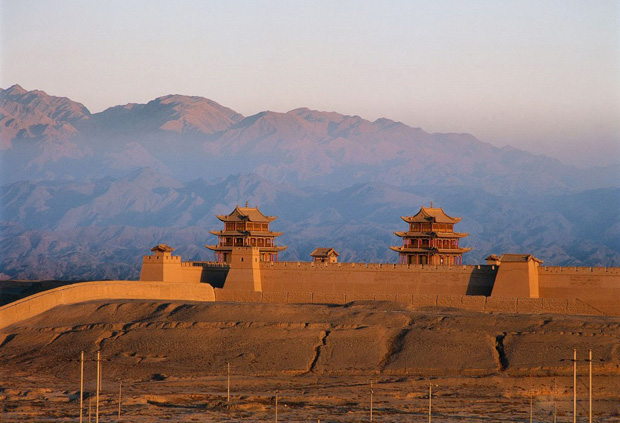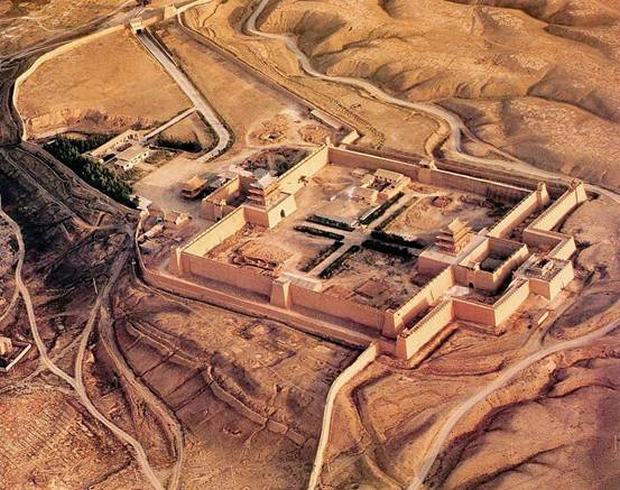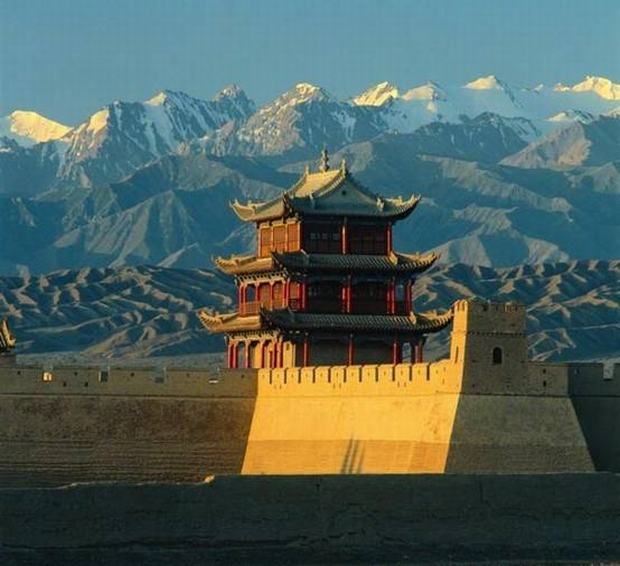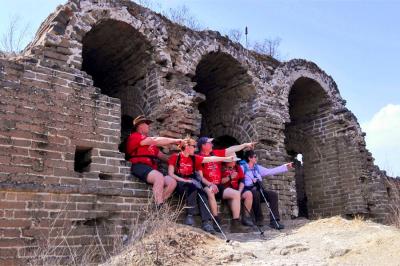Jiayuguan Fort (Jiayuguan Pass)
Jiayuguan Fort is facing Qilian Mountain in south and Mazongshan Mountain in north, only 15 km between the two mountains. The walls on both sides of Jiayugyan Fort pass cut across the desert Gobi, connecting the Hanging Great Wall in the north and “the First Pier under Heaven” in the south.
It is regarded as the "gullet" of Hexi Corridor along the Silk Road. Due to its strategic location, Jiayugyan Fort was dubbed the “Impregnable Defile Under Heaven” or “The Greatest Pass Under Heaven”. Jiayuguan Fort is also one of the three wonders of the Great Wall of China, along with Shanhai Pass and Zhenbeitai Fortress.

Jiayugyan Fort Facts
Where is Jiayugyan Fort Located - the Geographical importance
Jiayuguan Fort is the westernmost pass of the Hexi Corridor in western Gansu Province, which is part of China's desert region. The Hexi Corridor, which is about 1,000 kilometres long from east to west, is sandwiched between the majestic Qilian Mountains and the Northern Mountains (including the Horsehair Mountains, the Haili Mountains and the Longshou Mountains). The ancient Silk Road travelled through the Gobi and alluvial plains at the foot of the Qilian Mountains.
The road would have been treacherous. However, at the pass of Jiayu Mountain, narrow valleys pass through the mountain and dangerous slopes approach the road. Therefore, Jiayuguan's geographical position was very dangerous and important, leading to Suzhou (present-day Jiuquan) in the east and Anxi in the west. It was the transport link between Chang'an (present-day Xi'an), one of the ancient capitals of China, and the Western Region of China.The History of Jiayugyan Fort
Jiayuguan Pass, built in the fifth year of the Ming Dynasty (1372), is the largest existing pass on the Great Wall and the largest pass in China.
During the Ming Dynasty, in order to strengthen the northwestern border defence, Feng Sheng, the Duke of Song, decided to build a military pass here. Soon, Jiuyequan area rose up a yellow earth rammed city, 220 zhang in circumference, two zhang high, 3.33 metres wide. This is the earliest prototype of Jiayu Xiongguan.
During the Ming Dynasty, Turpan in the west became increasingly powerful and often led troops to invade the cities in the Hexi Corridor. The Jiayu Mountain Pass was the necessary place to pass through. Since the construction of Jiayuguan Fort, this pass has been the key point of defence in the west.
After that, the Guanlou was built during the reign of Emperor Xiaozong of Ming Dynasty. During the Zhengde period, two buildings were built in the east and west, i.e. Guanghua Building and Zuoyuan Building. Emperor Jiajing reinforced the existing buildings and built two wings of the Great Wall, with a pier every five miles. From the fifth year of Ming Hongwu (1372) to the eighteenth year of Ming Jiajing (1539), Jiayuguan Pass was built intermittently for 168 years, and it became a more complete defence castle.
Before the Yuan Dynasty and Ming dynasty, emissaries from the western regions paid tribute through the Yumen Pass. With the construction of Jiayuguan Pass in the Ming Dynasty, the Yumen Pass was abolished. The Jiayuguan Pass became the only legal route from Hami to the Hexi Corridor, and the Western region's envoys travelled to the Central Plains in the Ming Dynasty.
During the Qing Dynasty, an important Silk Road trade route from the Central Plains to Xinjiang started from Xian and travelled through Lanzhou, Jiayuguan and Yumen to Hami. Cotton and grapes from Turpan, sheep, horses, camels, antelope horns from Jungar and jade from southern Xinjiang were transported to the mainland via this road. Tea, silk, cotton cloth, porcelain and medicinal herbs from the central China were also transported to Xinjiang and Central Asia through Jiayuguan.
>> Recommend China Silk Road tours to Jiayuguan Fort:

The Jiayugyan Pass Complex and Fortress
When Jiayuguan Pass was first built, it was a 6-metre-high earthen city covering an area of 2,500 square meters. The total area of the existing military pass is more than 33,500 square meters.
Jiayuguan Fort includes three parts, inner city, outer city and moat. Connected with the Great Wall of China, This resulted in a defence system with a beacon tower at five miles, a pier at ten miles, a fort at thirty miles and a city at a hundred miles.The perimeter of inner city is 640 meters long, encompassing an area of 25,000 square meters. At the eastern end of the fort is the Gate of Brightness (Guanghua men) and in the west is the Gate of Conciliation (Rouyuan men). Over each gate stand 17m-high towers with upturned flying eaves. On the inside of each gate are horse lanes leading up to the top of the wall.The Defense System
Jiayuguan Fort guards a canyon about 15 kilometers wide from north to south. The southern part of the canyon is the Cholai River Valley, which constitutes a natural barrier for the defence of the pass. Jiayuguan Pass is crisscrossed with beacon flints and piers, and there are 66 piers in the east, west, south, north and northeast of the Pass. With the nearby Great Wall, platforms, trenches, flints and other facilities together, the fort constitute a tight military defence system.
What to See and Do at Jiayuguan Fort
Overhanging Great Wall
The Broken Wall and the Hanging Wall are important parts of the Western Great Wall of Jiayuguan Pass, which was built in 1540 by Li Han, the military governor of Suzhou. The Broken Wall is located south of the Black Mountain Gorge and runs east-west. The Hanging Wall is on the north side of the gorge, with a north-south direction, majestic, and known as the ‘Western Badaling’.
The Hanging Great Wall Cultural Relics Scenic Area is located 14 kilometers northwest of Jiayuguan City, 8.4 kilometers from Jiayuguan Fort. In addition to the Great Wall, the scenic spot also has a sculpture group of the ancient Silk Road and an exhibition of Jiayuguan's ancient weapons.
>> Related reading:Theatre
Jiayuguan Theatre was built in 1792, the 57th year of the Qianlong reign in the Qing Dynasty. It was a place of entertainment for the officers and soldiers guarding the city, the residents of the city and the merchants and travelers passing through the city at that time.It is a typical Chinese traditional classical theatre. The front and back stage are separated by a wooden screen. In the centre of the screen, there are eight figures, known as the “Eight Immortals”. On the top of the theatre is the traditional Chinese “Bagua” map, which is a comprehensive reflection of ancient Chinese culture, philosophy, and science.
On both sides is a group of murals, depicting the temple monk, nunnery nuns and their pets. These paintings are very rare in other Chinese theaters.

The First Beacon of the Great Wall
The first Beacon of the Great Wall was built in the 18th year of the Ming Dynasty (1539) under the supervision of Li Han, the military governor of Suzhou. It is the first pier of the Great Wall of the Ming Dynasty, the starting point of the western end of the Great Wall of the Ming Dynasty, and an important part of the defence system of the Great Wall at Jiayuguan.
7.5 kilometres away from the Jiayuguan pass in the north, and the pier stands on a cliff nearly 80 metres high on the edge of the Cholai River.
Guandi Temple
With a total area of 720 square metres, Guandi Temple has a main hall, two accompanying halls, a sword room, a hall, a stable and a pagoda.
In 1998, it was restored by Jiayuguan Guancheng Cultural Management Institute, and the pagoda was painted. So that the Guandi Temple restored the charm of the Ming and Qing dynasties.
>> Related reading: 6 Most Famous Stories of the Great Wall of China (at Jiayuguan Fort)
